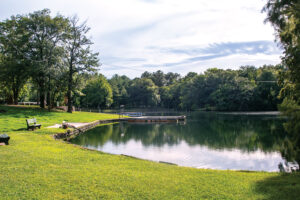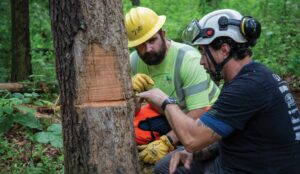
A house once stood in rural Paris, Ill. Dating back to the Civil War era, it was stripped of its windows, staircase, fireplaces, light fixtures and everything of value, and abandoned in the 1980s. Left to the elements, the house slowly deteriorated during the three decades that followed as nature reclaimed the land. Then during summer 2019, Mike and Cat Eads decided to breathe new life into the once grand estate.
“When we bought it, you honestly could not see into the property at all,” Cat explains. “There was no drive. There was an overgrowth of trees. We walked the property before we put in an offer and just fell in love with its potential.”
Mike is a master mechanic and part-time deputy, and Cat is a school administrator. They became weekend warriors as much of their time outside of work became dedicated to creating their new home. “I’m the visionary between us, and Mike works hard to see the vision come to fruition,” Cat says.
The 8-acre property, now on EnerStar Electric Cooperative lines, could have been compared to a jungle surrounded by farmland. Initially, the Eads spent much of their free time clearing the property of overgrown foliage, buildings beyond repair and items left by previous owners.
“We just go out and work ourselves to death,” Cat says. “It is a huge project, but we wanted some rural property … the peace of country living was something we desired.”
As they cleared their way to the large farmhouse in the back of the property, they knew renovating the home wasn’t an option and could never be restored to its former glory. Having been abandoned for so long and left to deteriorate, there was no way it could be saved.
“It was rotten,” Cat describes. “Complete walls had split open. Animals had been living in it, and rain and snow over all that time had just taken a toll on it. We couldn’t save the house.”
The Eads salvaged what they could with the intent to repurpose in the new home they are building. They managed to save several doors, as well as corbels (decorative wood brackets) that were attached to the top of the house and carved wood rope trim on every outside corner. “We saved what we could, hoping to use it in the new house,” Cat says. “We hope to bring some of the old into the new build.”
The Eads then completed the difficult task of demolishing the 150-year-old house.
“It was heartbreaking to tear it down,” Cat says. “Lots of people say, ‘Oh, it is such a shame you tore it down,’ but if you actually saw it, there was absolutely no way it could have been saved. If it was maintained through the years, it could have been salvaged, but that was not the case.”
 As they cleared the property to make room for their new home, they tore down a total of four structures, and along the way, many discoveries were made. They’ve found architectural pieces from old buildings, three old jail cell doors, glass bottles, boulders and much more.
As they cleared the property to make room for their new home, they tore down a total of four structures, and along the way, many discoveries were made. They’ve found architectural pieces from old buildings, three old jail cell doors, glass bottles, boulders and much more.
“There are literally millions of rocks on the property,” Cat says. “Huge boulders that we struggled with a backhoe to move, and we’re not exactly sure how they came about being on the property.
“It has been an ongoing discovery. You don’t realize how much leaf and stick decay adds to the surface soil. When we thought we’d have an area cleaned up, we would get a hard rain and find some beautiful knobs or tiny jars or glass bottles that we’ve driven over with heavy equipment multiple times and somehow survived.”
However, Cat believes they’re nearing the end of their discoveries as they’ve finished clearing the areas for their work and living spaces. They plan to leave the rest of the property untouched for wildlife.
“Natural preservation is super important to us,” Cat says. “We are just temporary caregivers of the land.”
To do that, Cat enrolled in courses at her local University of Illinois Extension office and became a master gardener. “I’ve always loved gardening,” she says. “I’m big on pollinators and promoting and increasing plant life for pollinators. … Our goal is to always work to increase the native plant species that should be in Illinois.”
One of the first structures placed on the property was Cat’s gardening shed, which was a surprise gift from Mike. From there, she can focus on helping pollinators like bees and butterflies. Behind the gardening shed are her beehives, which were installed in May 2021.
“I’ve enjoyed it for sure, but it was a learning process,” Cat says about her beehives. “We need pollinators, so part of my plan was to have hives. … The whole thing was a little scary, especially when you have two hives of bees in the back of your car.”
The property is a stopping point for monarch butterflies during their migration.
“The first year we were here, we thought it was crazy,” Cat says. “There were hundreds and hundreds of monarchs, and to help [them] continue their migration successfully, it was important to develop pollinators and plant life that serves as food sources for the butterflies.”
Cat was quickly able to develop her pollinator garden, and she credits her friends in the community for thinning out their own perennials and giving them to her.
“That’s the gardening mindset – to share what you have with others and help them get started,” she says. “We would come home from work and there’d be either new plants or 5-gallon buckets full of roots to help us start. That’s why it is so beautiful already. They’ve had a chance to establish at an early point in our process of making our home.”
The property has received several certifications including a certified bird and butterfly sanctuary from the Illinois Audubon Society, a certified wildlife habitat from the National Wildlife Federation, a certified monarch garden by the North American Butterfly Association, and several others.
“Each organization is a little different with their qualifications,” Cat says. “A water source is always important.”
With that in mind, they decided to add an acre pond to the once dry property. As luck would have it, a natural spring under the property filled the pond. They then stocked the pond with native plant life and fish, which are thriving.
However, the fish aren’t the only animals enjoying the water source. Throughout their time on the property, the Eads have been observed by the watchful eyes of the red-tailed hawks living there.
“When we pull in, the hawks like to circle around and see what we’re doing. I think they like what we’ve done, especially the pond because that’s brought a lot of wildlife. We are kind of an oasis in the middle of all this farm ground.”
In honor of the birds, the Eads decided to name the property Red Tail Ranch. “It is pretty cool to see them thriving in the area,” Cat says. “They do nest here and raise young hawks.”
The Eads’ new home is a work in progress, and they aren’t putting themselves on a timeline to finish. “We don’t have to give ourselves a deadline,” Cat says. “From our experience and talking to others who have been through the building process, that’s a lot of the stress, so we are making it as stress-free as possible. We have a home, so we don’t need to hurry.”
The new build will be a ranch style metal home the Eads designed themselves, focusing more on practicality than designing a showplace to best fit their needs when they decide to retire.
In the future, Cat hopes to use her garden area for educational purposes. “There are all kinds of possibilities, and we are just going to wait to see what happens. We want to share with other people, and that comes from how many people have been interested in what we’re doing on social media.”
In fact, Cat has documented the progress of Red Tail Ranch every step of the way by blogging their journey online.
“It became hot news [in the area] that someone decided to do something with the property,” Cat says. “People knew it sat there all this time and were encouraging us along the way and wanting to know about our progress.”
Cat began posting photos and updates on her personal Facebook page, but as interest grew, she decided to create a Facebook page dedicated to the project.
“Originally, it was just a way to keep everything together,” Cat says. “It was incredible how many people were interested in our story and encouraging us. People we didn’t even know started to join the page. It just grew and grew.”
As of publication, the Facebook blog has attracted 6,000 followers and counting. “It surprises me, but it is also encouraging because people we don’t even know say very nice things that help us when we’re tired.”
For updates on the Eads’ journey to create their new home, search Design Forever Home & Red Tail Ranch on Facebook and YouTube and designforeverhome on Instagram.










